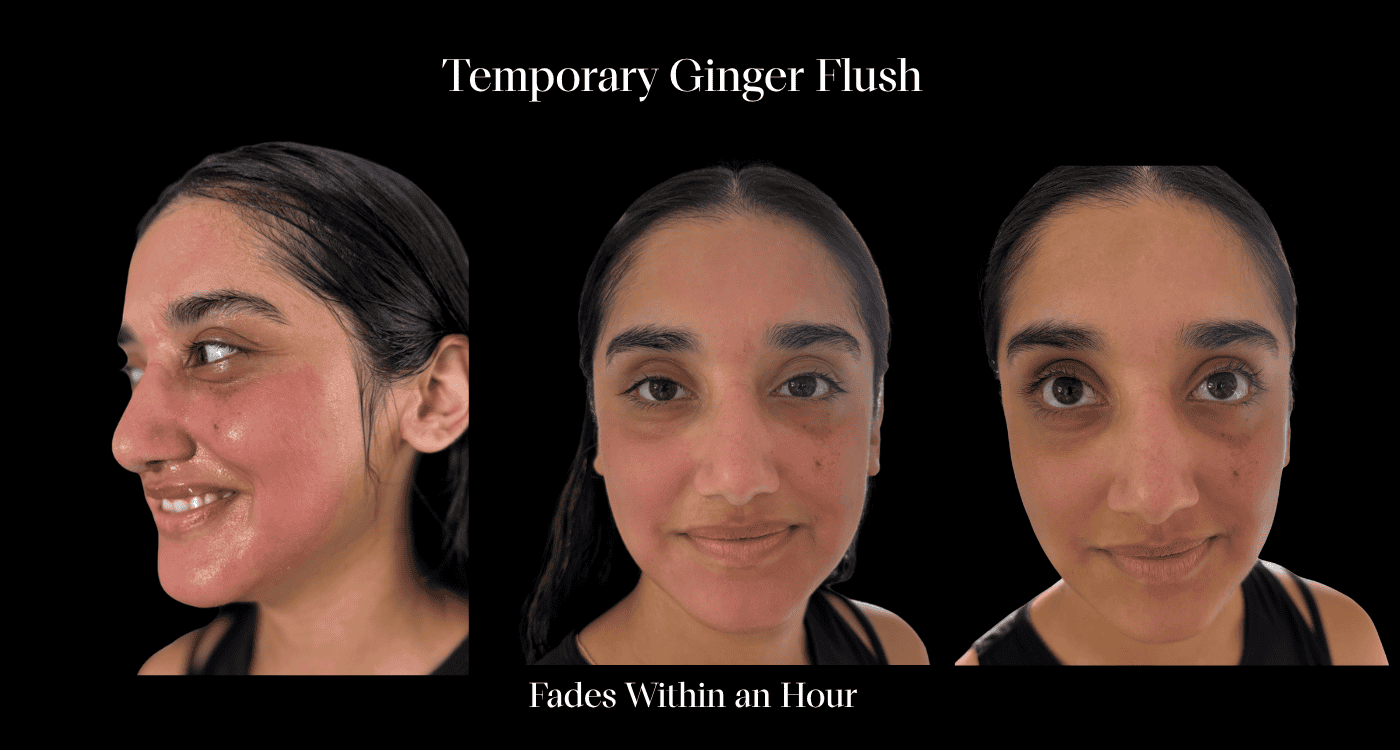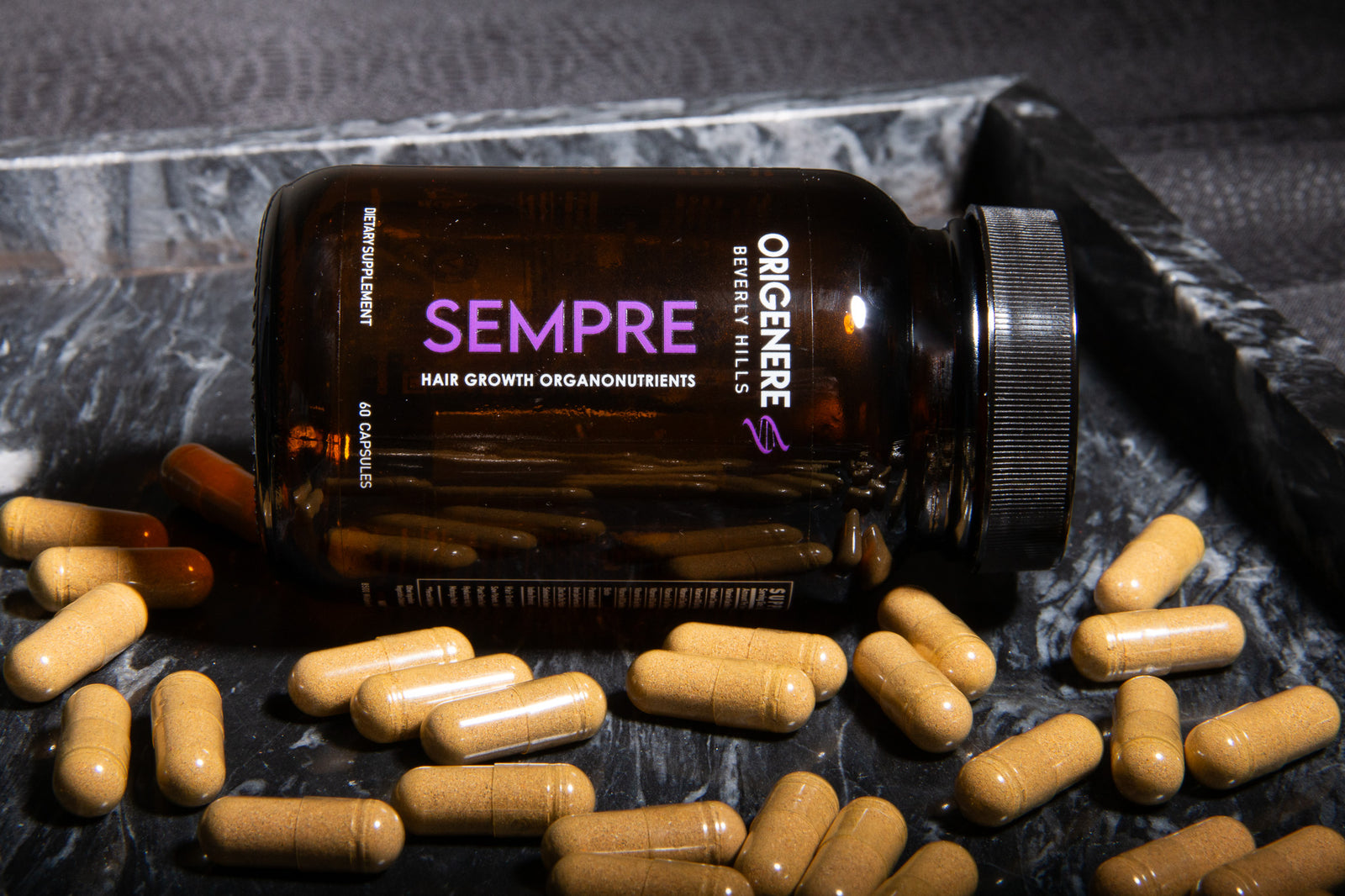Ginger Flush Reaction: If It’s Turning Your Skin Pink, Imagine What It’s Doing Beneath the Surface

A candid note
A tester of Nero ginger-based scalp and face mask said:
“My face turned really red after using the mask.”
We get it. Seeing that pink flush in the mirror can be unexpected. But here’s the other side: that temporary warmth and color is a visible sign of ginger’s actives at work. By briefly activating sensory receptors and boosting circulation, ginger is delivering the very same mechanisms that support scalp comfort, follicle vitality, and skin barrier resilience.
Why that flush happens and why it’s not a bad thing
TRP channels: the skin’s “antenna system”
Ginger’s pungent actives—especially [6]-shogaol, along with [6]-gingerol and zingerone—interact with transient receptor potential (TRP) channels in cutaneous sensory neurons. In whole-cell patch-clamp experiments:
-
TRPA1 is activated by ginger actives; [6]-shogaol strongly, dose-dependently activates this channel (blocked by the TRPA1 inhibitor A-967079).
-
TRPC5 is inhibited by [6]-shogaol at an IC₅₀ of ~18.3 µM.
-
TRPM7 shows no meaningful response at tested concentrations.

This explains why some people feel a short-lived warmth or tingling — the same receptors that signal “heat” and “spice” are being lightly engaged. (Kim et al., Int J Mol Med, 2016; doi:10.3892/ijmm.2016.2791)
Circulation boost you can see
Topical ginger also promotes mild vasodilation, expanding superficial capillaries. That momentary increase in blood flow appears as a pink flush. Far from harmful, this is a predictable vascular effect and one reason ginger has been explored for scalp microcirculation support.
Science note: [6]-Shogaol stands out as the most potent player here — activating TRPA1 while inhibiting TRPC5 — a pattern consistent with a brief sensory signal, not tissue injury.
What it looks like in real products
One place where the ginger flush reaction may show up is in multi-action treatments like the Nero Scalp & Face Detox Mask. The formula combines ginger root extract and ginger root oil with clays (like kaolin) to help clear buildup, plus a wide range of botanical oils and actives—including almond oil, aloe vera, Boswellia, grape extract, and niacinamide.

Here’s why this combination matters:
-
Ginger + circulation support: The mild flush from ginger helps stimulate surface blood flow, while aloe vera and Boswellia (frankincense) calm reactivity, helping the skin reset after that temporary tingle.
-
Ginger + barrier reinforcement: When paired with upcycled Picea mariana bark extract and niacinamide, ginger’s sensory activation complements ingredients that strengthen the skin and scalp barrier.
-
Ginger + hydration synergy: Oils like sweet almond and camellia (tsubaki) replenish lipids while ginger helps improve product penetration by temporarily boosting circulation.
The result is a formula that delivers both the “wake-up call” effect of ginger and the soothing, replenishing balance of companion botanicals. For most users, that means the flush fades within an hour, leaving skin and scalp feeling refreshed, not stripped.
Flush vs. irritation: how to tell the difference
The ginger flush is:
-
Quick in onset (within minutes)
-
Brief in duration (fades in 30–60 min)
-
Mild in sensation (warmth, tingling, slight pinkness)
By contrast, irritation or allergy looks different:
-
Persistent redness or swelling beyond an hour
-
Burning, stinging, or hives
-
Itchiness or rash
The key difference: flushing resolves on its own. Irritation lingers and escalates.
Making the flush more comfortable
-
Patch test first (behind ear or forearm, 24 hrs).
-
Start with shorter applications (5–10 minutes).
-
Apply on damp skin to reduce intensity.
-
Buffer with calming ingredients like aloe or rose water.
-
Limit to 1–2× weekly until tolerance is known.
-
Rinse with cool water if sensation feels stronger than expected.

Conclusion
The ginger flush reaction is a short-lived sign of ginger’s unique interaction with skin and scalp physiology. By briefly engaging TRP sensory channels and encouraging mild vasodilation, ginger produces a visible pink warmth that usually fades within an hour. For most, it’s harmless — and even a reminder that the actives are at work.
What matters most is how ginger is used in context. On its own, it can feel strong. But when paired with calming agents like aloe, Boswellia, and grape extract—as in the Nero Scalp & Face Detox Mask—ginger’s stimulating qualities are balanced by botanicals that soothe, hydrate, and reinforce the barrier. The result: a ritual that feels both energizing and restorative.
By recognizing the difference between a flush and irritation, and by understanding the science behind it, users can approach ginger-based treatments with confidence. Instead of seeing the flush as something to fear, it can be viewed as a natural, visible signal of activity beneath the surface—a bridge between sensation and long-term skin and scalp health.
FAQs
1) What is the ginger flush reaction?
A short-lived warm, pink tingling caused by TRP-channel signaling (notably TRPA1) and mild vasodilation from ginger actives like [6]-shogaol.
2) Is it harmful?
No. In vitro and clinical data indicate this is a benign, physiologic effect that fades within an hour.
3) How can I tell flush apart from irritation?
Flushing = quick, mild, and fading. Irritation = persistent, burning, or accompanied by rash/hives.
4) Why does ginger cause warmth or tingling?
Its pungent actives activate sensory TRP channels — the same ones that respond to chili peppers or warmth — producing a temporary tingling signal.
5) Does flushing mean ginger is “working”?
It shows ginger is engaging sensory and vascular pathways. Long-term benefits for scalp and skin health come from its antioxidant and anti-inflammatory effects, not the flush itself.
6) How often should ginger-based treatments be used?
Most people do well with 1–2 times weekly until their skin adjusts.
Sources
-
Pedersen, S. F., Owsianik, G., & Nilius, B. (2005). TRP channels: An overview. Cell Calcium, 38(3–4), 233–252. https://www.sciencedirect.com/science/article/abs/pii/S0143416005001156
-
Kim, Y. S., Hong, C. S., Lee, S. W., Nam, J. H., & Kim, B. J. (2016). Effects of ginger and its pungent constituents on transient receptor potential channels. International Journal of Molecular Medicine, 38(6), 1905–1914. https://www.spandidos-publications.com/10.3892/ijmm.2016.2791?text=fulltext
-
Sugimoto, K., Takeuchi, H., Nakagawa, K., & Matsuoka, Y. (2018). Hyperthermic effect of ginger (Zingiber officinale) extract-containing beverage on peripheral skin surface temperature in women. Evidence-Based Complementary and Alternative Medicine, 2018, 1–8. https://onlinelibrary.wiley.com/doi/full/10.1155/2018/3207623
- Yoon, Y. C., Anh, N. H., Kim, S. J., Long, N. P., Min, J. E., Yoon, Y. C., ... & Kwon, S. W. (2020). Ginger on human health: A comprehensive systematic review of 109 randomized controlled trials. Nutrients, 12(1), 157. https://pubmed.ncbi.nlm.nih.gov/31935866/





Leave a comment